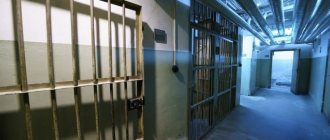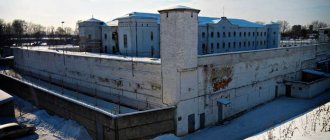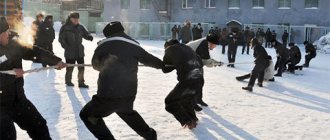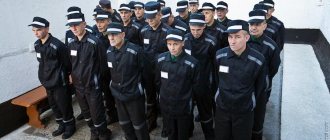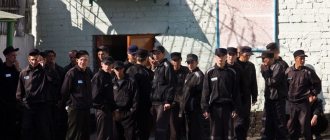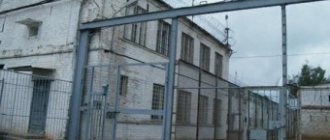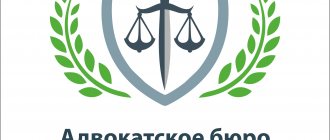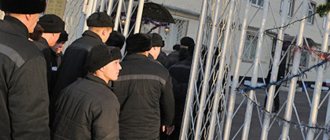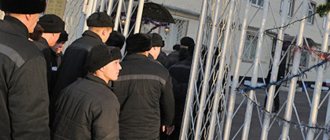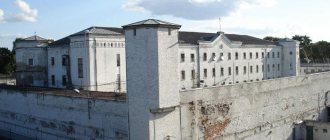Russia has experienced a huge number of upheavals over the past hundred years. Revolution, war, “hunger years”, years of stagnation, perestroika, redistribution of property, gangster 90s... During the time of Stalinist repressions, millions of people were in camps; after the war, all those captured were recognized as enemies of the Soviet state and were sent to a new stage; in the 90s, people tried to survive as best they could, many went into racketeering, and with the advent of legality they were sent to prison zones. As a result, by the beginning of the 21st century, prison life affected almost every family - if the person himself was not in prison, then among his relatives or friends there was always someone who had visited places not so distant. Finding a family now that does not have such a skeleton in their closet - among brothers, uncles, distant relatives or friends - is extremely difficult.
First option for zone classification
The first classification gives us the following definition of what the red zone is. According to this classification, zones differ in their population. The Red Zone is a correctional colony for former law enforcement officers. The black zone is a colony where civilians serve their sentences. Red zones in Russia according to this classification are intended not only for former police officers, but also for prosecutors, military personnel, employees of the Investigative Committee, bailiffs, and jailers. Putting them in the same cell with the contingent that they themselves brought to justice only means increasing crime in the colonies.
Which zones in Russia are “red” according to this classification? Former law enforcement officers serve their sentences in the following places:
- Nizhny Tagil, Sverdlovsk region, IK-13.
- G. Bor, Nizhny Novgorod region, Borsky district, IK-11.
- G. Skopin, microdistrict Oktyabrsky, Ryazan region, IK-3.
- G. Engels, Industrial zone, Saratov region, IK-13.
- Pechora town, Misha-Yag village, Komi Republic, IK-49.
- Republic of Mordovia, Zubovo-Polyansky district, Leplei village, IK-5.
- Irkutsk, IK-3.
Which zones and for what reasons became “red” or “black”?
In the era of early Stalinism, all camps were essentially “red” - strict control of camp administrations was ubiquitous. But the situation was turned around by the “bitch wars” of the forties and sixties: where the “bitches” took power, the zone became “red”, and where the “thieves in law” ruled, it became “black”.
There were colonies that throughout their history changed their “color”: either the administration began to harshly suppress the arbitrariness of the inmates, or the prisoners, under the leadership of the “thieves,” staged riots...
In general, for a long time the following pattern was observed: “black” zones more often became near large cities (or if the prison territory was within the city). If the city had an authoritative “supervisor” and a close-knit criminal community, then the places of deprivation of liberty became subordinate to him.
In cities, it is easier to maintain a “back door” - “warmth” from free criminal elements is transferred to prisons, drugs and alcohol are traded (illegal, of course), money received from prisoners goes to the thieves’ “common fund”, etc. Moreover , in cities it is easier for criminals to organize pressure on pre-trial detention center employees, who live in these same cities with their families and, accordingly, cannot always guarantee their personal safety.
The situation with remote colonies looks different. Located at a considerable distance from populated areas, sometimes in harsh natural conditions (for example, in the northern part of Russia), these colonies are not at all suitable for connections with the outside world, and it is technically very problematic to organize a “back door” there.
In addition, in conditions of remoteness from cities, riots and all kinds of sabotage are much more dangerous for the prisoners themselves, even authoritative ones - the administrations of the colonies take more stringent measures to suppress such actions, and every prisoner understands that the courts and lawyers are also far away - to prove facts of abuse of power, etc. ... precedents by the colony administration are very problematic. Therefore, most of these colonies are “red”. Historically, in the harsh “red” colonies, more brutal pressure was put on the “thieves in law” - some of these colonies are famous for a large number of “decorations”.
There were (and still are) prisons and colonies that a priori can only be “purely red”: these are special correctional institutions for former employees of the law enforcement and judicial systems. All these people in ordinary zones (whether “red” or “black”) are considered a priori outcasts, “cop guys”.
They fall into the lowest caste of prisoners and for them there is always a danger of being killed - since the murder of a “cop”, even if he is serving an officially assigned sentence, is considered a highly encouraged act in the eyes of the “thieves”. So, for the safety of these people, from about the fifties, special prisons began to be built, where there were no thieves or “men” - only former police officers, traffic cops, judges, investigators, prosecutors and lawyers who had committed crimes.
The current Russian trend is a significant reduction in the number of classic “black” zones. But in contrast to this, the leadership of “red” colonies and prisons, on the contrary, is increasingly interacting with criminals, because they have their share of drug and alcohol trafficking or some other benefits.
Second example of zone classification
Nowadays, another meaning is increasingly used when dividing colonies by color. What is the red zone according to this classification? This is a colony where the administration and activists “run the show.” Here, interaction between prisoners and the zone administration is encouraged. Thieving traditions are strong in the “black” zone; in parallel with the administration, there is a strong “institution of overseers”; life is built on prison laws.
What is the difference between the red zone and the black zone? Features:
- Power lies with the “activists” and the administration.
- There is no free circulation of alcohol and drugs.
- The prisoners are busy working and do not hang around idle.
- It is customary to greet every employee.
What it is?
A “red” prison is one in which the law rules. There is not the slightest deviation from state documents. Everything is as per the instructions. It often happens that in the “red” zones, prisoners cooperate with prison employees.
In such detention centers, the law is executed with meticulousness, which sometimes becomes more difficult for the prisoners than the punishment itself, because... for the slightest disobedience they will face very serious punishment from the jailers and other representatives of the prison authorities. The administration of the correctional institution does not see the limits of its power, so punishments often include isolation in solitary confinement, deprivation of any rights (they may be deprived of a walk, lunch, etc.), and sometimes beatings.
Conditions of detention in a colony-settlement
The mildest type of punishment associated with imprisonment. Those sentenced to a term not exceeding 5 years are held here for crimes committed through negligence. Also, those prisoners who have proven themselves well in general and maximum security colonies are transferred here.
In a colony-settlement there is no strict security; here the concept of “under supervision” is more used. Convicts have the right to move without restrictions within the territory of the colony from waking up to bedtime. They are allowed to wear civilian clothes, receive parcels, use pocket money without restrictions, and receive visits. They live not in cells, but in dormitories. Moreover, if a convict has a family that would like to live with him, then this is not prohibited by the colony administration. Families are allowed to live in rented housing on the territory of the colony. But we must understand that this is not a resort; the administration of the colony settlement has the right to check such housing at any time of the day.
The work of such convicts is paid in accordance with labor regulations. And if you want, you can even get an education, but only in absentia and within the boundaries of the administrative-territorial entity.
“Red” and “black” zones - how did such a division arise?
From Soviet times to the present day, prisons and correctional colonies have been divided into so-called “black” and “red”.
And very briefly, these names designate who holds the real leadership in the place of deprivation of liberty: the official administration and employee-supervisors - or privileged prisoners, “thieves.” Let’s start with what these color names themselves mean.
Since the days of the Gulag, “blacks” have been called “thieves in law” and generally “thieves” - that is, representatives of the “cream” of prison society.
These are people with criminal histories who have authority and influence both within a specific zone and in the criminal community in general (their status did not change from moving to other correctional institutions).
Where the real masters establishing order in the zone were thieves in law, the zone began to be considered “black”.
As for the “reds”, the interpretation is more multifaceted. Since Soviet times, inmates have called all law enforcement officers in general and prison guards in particular “Reds.”
Why exactly “red” - simply in honor of the red banner of the Soviet Union and other accompanying symbols.
But, in addition, such a prison caste as “activists” (they are also “goats”) is sometimes called “red”: that is, people who actively cooperate with the administration - it is logical that such characters are present in the “red” zones.
Conditions of detention in a general regime colony
Here are those convicted of serious crimes, if this crime was committed for the first time. The second category is those convicted of crimes of minor and medium gravity, if the court found it impossible to reform in the conditions of a colony-settlement. And one more category - convicts who have reached the age of 18, who served their sentence in a correctional colony until they came of age. There are general regime colonies for both women and men.
Conditions here are harsher than in the settlements. Less freedom, more restrictions. They live in locked rooms. There are workdays: 8 hours of work, an hour break for lunch, according to the Labor Code of the Russian Federation. The number of dates is limited - 6 short-term and 4 long-term per year. The number of parcels is also limited - only six for the same period.
In general regime colonies there is also the opportunity to get an education and participate in cultural and sports events. Management, as a rule, creates all the conditions for this.
What are the benefits of “black” zones?
The difference in order in the zones of the “red” and “black” types is obvious. “Black” zones are good for prisoners with relaxations in the regime and rules - you can wear different clothes, receive transmissions from outside more freely, use modern means of communication, sleep during the daytime, and much more. etc.
In some "black" zones there is even the possibility of obtaining drugs and alcohol - but not in all. The downside is that they must strictly adhere to the “concepts” and rules of the prison hierarchy, since in the event of conflicts, harsh thieves’ laws can work before the official ones.
Conditions of detention in a maximum security colony
Persons whom the court considered the most dangerous to society and, accordingly, require strict isolation are kept here. These are those who have committed, for example, the intentional murder of two or more people or a contract killing. They also end up in such a colony for recidivism.
Convicts are kept in locked cells. Beds are in two or three tiers; an area of no more than 7 m² is allocated per prisoner. 4 parcels and 4 parcels per year are allowed; three long and three short dates. You cannot spend more than 2 minimum wages on food in the colony stores.
And, of course, the main difference is the contingent. In a maximum security colony, a “first mover” is a rarity. Most of those convicted are those who chose a life of crime as their life credo.
“A truly regime colony”
“If you ask human rights activists, if you ask convicts, if you ask relatives of convicts, then of course they will say that the colony is definitely a torture colony. But if you ask the same FSIN employees, they will say that this is an ideal, exemplary colony, where everything is in order,” says Oleg Khabibrakhmanov.
According to him, the very fact of Vasily Voloshin’s fairly rapid rise from the post of junior inspector to the post of head of the colony shows that the leadership of the regional department of the FSIN was quite satisfied with the results of his work. “It was believed that this was a wonderful, as the FSIN employees said politically correctly, a truly regime colony. As the head of the colony himself said, it is ideal, exemplary, where everything is as it should be according to the law. With such a point of view, it has a right to exist, we must also take it into account,” argues Khabibrakhmanov.
He says that human rights activists have been receiving reports of violence and torture in IK-14 for many years, but they have not been able to bring anyone to justice - administration officials masterfully destroyed evidence, prisoners who wrote complaints were intimidated into retracting their words, and the prosecutor's office I didn't notice any problems at all. Khabibrakhmanov notes that from the entrance to the prosecutor’s office in Sukhobezvodny to the gates of the colony is a couple of hundred meters, but prosecutor Sergei Morozov, whose duties included overseeing the rule of law in IK-14, was, according to the human rights activist, “stunningly blind.”
Convict-activist Nikolai Molotov recalls an episode when, after another death in a colony, he was present “at the conversation between Stepanych (we are talking about Vasily Stepanovich Voloshin - MZ) and Morozov about this corpse,” and just then “Morozov advised how to do everything correctly” . According to Molotov, Morozov and Voloshin together watched a video recording of the last hours of the beaten prisoner’s life and “the recording had to be destroyed.” “How much this Morozov drank and ate, it’s time to work off” - this is what, according to Molotov, Voloshin allegedly said when he hung up after a conversation with the prosecutor, during which he asked to “destroy the papers” of the next inspection.
“We couldn’t collect evidence there,” says Khabibrakhmanov, “because relatives report that our man is being tortured, we are going, indeed, he was beaten. We are taking him for examination: indeed, there are ruptures of the rectum, anus, and everything else. The prosecutor comes and takes an explanation from him. He says: “Guys, I was tortured so much, I simply have to put these bitches in jail.” Two weeks pass, and the information turns 180 degrees. Now he not only inflicted these bodily injuries on himself, he inflicted them at the instigation and under pressure from members of the POC!”
Ivan Zhiltsov, another member of the Nizhny Novgorod Public Monitoring Committee, explains that the prisoner who spoke about particularly sophisticated torture (“Judging by his stories, they shoved a rubber hose up a man’s ass and let water run through him,” Khabibrakhmanov clarifies) remained on the premises during the check and investigation. colonies. Thus, the FSIN employees did not transfer the victim to another place and did not ensure his safety; Even urgent communication of the complaint to the ECHR did not help. As a result, the prisoner retracted his words, and the case was closed. Zhiltsov suggests that the desired effect was achieved from the prisoner not even by threats or new violence, but by the promise of help with the closure of his own case and subsequent release.
“This is an opera, this is a very competent opera, this is far from a stupid opera, this is a very cunning opera. Another thing is that, at first glance, he was very much let down by the complete lack of any strategic thinking,” this is how Oleg Khabibrakhmanov characterizes the head of IK-14 Vasily Voloshin. According to him, Voloshin “clearly believed that only he in this environment understood something,” and brushed aside warnings that such a regime could not exist for long and would “certainly explode.”
The leadership of the GUFSIN in the Nizhny Novgorod region, as well as the prosecutor’s office and the Investigative Committee, did not react in any way to reports about the situation in the colony. “There is no understanding - because there is silence in the colony, there are no complaints from there.”
Conditions of detention in a special regime colony
People don’t end up here by accident, “by stupidity” or “by negligence.” It contains those criminal elements who have clearly been recognized as dangerous to society and who should not be among free people. Special regime colonies are colonies for those sentenced to life, for those sentenced to death, but who received a commutation of death by life imprisonment, and for those sentenced to 25 years - in practice, few of them survive to the end of their sentence.
Why can you end up in a special regime colony? These are the crimes that make the hair on the back of an ordinary law-abiding citizen stand on end. These are serial murders, serial rapes, terrorist attacks. Here sit cannibals and maniacs, sadists and fanatics. A prisoner who has committed a particularly serious crime while serving time in another colony can also end up here.
In colonies marked “special regime” there is no place for minors, women and men who have reached the age of 65 - the conditions for serving their sentences are too strict.
There are seven such colonies in Russia. Each has its own unofficial name: “Black Golden Eagle”, “White Swan”, “Vologda Pyatak”, “Torbeevsky Polar Owl”, “Mordovian Colony” and “Black Dolphin”. The living conditions can be examined in more detail using a specific example of the Black Dolphin colony.
Orders in the “red” zones
One of the biggest fears of “correct” criminals is ending up in a “red” colony. There, order and discipline are maintained by prisoners collaborating with the colony administration. For this they receive certain relaxations in the regime. In addition, inside the “red” prison itself there is also a division into sections. For example, prisoners are assigned to the law enforcement, sports, or hygiene and cleanliness sections. Failure to comply with section rules usually results in severe penalties.
In most “red” prisons, arbitrariness reigns on the part of the administration. The slightest offense - an untimely smoke break or a swear word during a round - and the prisoner can end up in a punishment cell. Or they will use other methods of punishment, including assault. They learn about all violations in the administration only from informers - “goats”. And even thieves in law who find themselves in the “red” zone cannot fight them. Here, unlike other prisons, they have no authority. Moreover, thieves in law are often transferred to “red” colonies in order to break their will. They are forced to break the thieves' code and work for the administration. Some agree to cooperate voluntarily, but many have to be broken long and hard.
In the “black” prisons of Russia, completely different laws reign. They are run by thieves in law.
"Black Dolphin": a prison for lifers
Correctional Colony No. 6 of the Office of the Federal Penitentiary Service for the Orenburg Region (official name) owes its poetic name to the fountain with a sculpture of a black dolphin located in the courtyard of the institution. This prison can house 1,600 inmates. Currently, 863 people are serving sentences there. The number of prison staff is even higher - 900 people. The administration of the colony strictly maintains security. Such precautions bear fruit - no one has ever escaped from this place.
The Black Dolphin prison for lifers is famous for its strict daily routine and harsh rules for keeping prisoners. Random people don't end up there - this prison is intended for the most hardened criminals. So, for example, Vladimir Nikolaev, a famous Russian cannibal, who in the 90s killed two of his drinking buddies and used their meat as food, is serving his sentence there. Nikolai Astanov will sit there until the end of his days - he killed an entire family and burned their bodies in the forest. The lives of these criminals and other non-humans are built according to a single algorithm, day after day, year after year:
- Rise at 6 am. From this moment until lights out, prisoners are prohibited from sitting or lying on their bunks.
- The size of the chambers is 4 x 5 square meters. m. In such a “cage” there are one or two prisoners. The “neighbors” are selected by a psychologist.
- Impossibility of being left alone: prisoners are monitored 24 hours a day, 7 days a week. It is forbidden to cover your head with a blanket. The duty officer comes by every 15 minutes.
- When transferred from a cell to other rooms, prisoners are blindfolded to disorientate them. They move bent over to eliminate the possibility of escape.
- There is no dining room here. Food is pushed through holes in the doors. The menu is not very varied - porridge, soup, bread.
- Every day, an hour and a half - a walk in the fresh air, in any weather. At this time, the administration checks the cameras for the presence of prohibited items.
“Black Dolphin” is not a prison where people end up “just like that,” having lost their way, through stupidity or misunderstanding. These prisoners are responsible for a truly enormous number of crimes. The number of lives that these 800-plus people took is more than 3,500. 4 lives for each criminal. Scary numbers.
"Correct" prisons
All criminals know that deviating from the laws of thieves faces a terrible retribution. Therefore, in the “black” colonies there is peace and grace for everyone who follows these laws. The authorities in power do everything possible to ensure that their “wards” have a good life. They establish a connection with the will, and for special merits they can even smuggle a cell phone into the zone. The administration turns a blind eye to prohibited things, alcohol and drugs in “black” prisons.
They also turn a blind eye to the fact that prisoners do not carry out the work assigned to them. For example, in the “black” zone, prisoners do not clean the area and refuse to wash their cells. However, this is a small price to pay for the fact that in the “black” colonies there are practically no murders or fights, unlike the “red” and “green” zones. Today there are fewer and fewer “black” prisons. But on the contrary, there have been more “greens” over the past few years. And the orders in them are somewhat different from the zones of other colors.
Hell of administration
© flickr.com
The bulk of the prisoners in the “red” camp are undoubtedly suffering. Convicts in security detachments are not busy with anything and gradually become dull in front of the TV or radio with a daily program about internal regulations (IVR). In the production - work - detachments, prisoners, on the contrary, from morning to evening plow for the enterprising head of the colony in the industrial zone. However, compared to a simple activist from the SDP detachment, any other prisoner lives luxuriously.
When in a “red” camp an ordinary prisoner without connections and money ends up in the SDP system, he has little choice: to resign himself and do whatever he is told, or to suffer from bullying, and then still resign himself and do whatever he is told.
After two weeks of quarantine hell, the prisoners are distributed by the administration into units and positions. Those who, for one reason or another, end up in the SDP are unlucky. At a minimum, they will have to sleep much less than they should, and, on the contrary, get much more damage from the liver.
The first three days the neophyte teaches the camp administration. This means that in the free time between getting up and going out, the prisoner sits and, like a poem in school, teaches the names, titles and positions of all those representatives of the administration who work in the camp. It’s easy to confuse dozens of names and titles; not all prisoners know Russian well, but in the tight atmosphere of fear so skillfully created by sadistic activists, only a few fail the administration exam. Those who never learned to recite poetry at school were later severely beaten in the SDP camp.
Theoretical cramming is replaced by practice in the camp. If you look at the camp from a bird’s eye view, you can see “esdepuriks” at all intersections and key points. Each of them has a notebook in their hands and a pencil behind their ear. In the camp, SDP activists monitor everything and everyone: they record the movements of administration employees, keep time and write about the routes of those prisoners who are interested in the operas or the top of the SDP, eavesdrop on conversations and even try to recruit ordinary prisoners into their agents.
"Cop colony." 2022, penal colony IK-40, Kemerovo.
The “Esdepushnik” is obliged to know by sight all the employees of the administration, and from afar to recognize by the gait of any employee of the colony. Therefore, newcomers stand, for example, on the corner of the headquarters and spend hours looking at the “gateway” - the entrance doors to the camp. As soon as they notice an employee appearing, they immediately signal with gestures to the next “esderupik” point about thirty meters away and write down the time and code of the employee on a piece of paper. To ensure that the recordings are accurate and the communication is instantaneous and at the same time not readable by a casual observer, all signals and notes are encrypted. Each administration employee was assigned a code in the form of a number and a gesture by the top of the SDP. As soon as some deputy chief goes out on a round to the camp, news flies ahead of him: so-and-so has left headquarters and is going to the zone. The central nodes of the camp’s nervous system come into combat readiness: they hide prohibited items, spruce up the units and facilities, and prepare reports.
With the help of prisoners, the administration also monitors its own employees. At any round and during detachment planned searches, an “esdepurik” is always present and writes what was seized and from whom, what time the search was completed and how many packages with seized things were delivered to the duty room. In this way, the “owner” of the camp eliminates the possibility of corrupt connections between prisoners and employees.
The SDP also carefully monitors the prisoners, although not the entire mass, but only those who are on the pencil. Professional accountants and legally literate prisoners, impudent people and potential rebels - all those prisoners who are of some interest to the operatives are taken under special control, “on a pencil”. “Esdepuriki” is what they call them – “pencils”. Their conversations are written, their movements around the camp are written, their time to go to the toilet is written. No video cameras or smart surveillance systems are needed: prisoners monitor and report just as well, but much cheaper.
Don't get there
© Mikhail Metzel/TASS
It is difficult, but possible, to avoid working in the SDP. The rare few who are not ready to put up with the need for denunciations break glass in the detachment and cut their wrists or jump out of the window onto the asphalt. Some even decide to rip their own throat open during a short meeting with their mother, just so that they can return him after the medical unit, even to a punishment cell, but no longer to the SDP.
Most of the spirited prisoners after the medical unit, of course, change their place of stay, sometimes even to a punishment cell until the end of their sentence. But the administration also makes cynical decisions: even at night the prisoner was running around the camp shouting “help, they’re killing him!”, and in the morning, stitched up and treated, he was returned from the medical unit to the same SDP detachment from whose torture he escaped. So, many stop even thinking about the possibility of breaking away from the detachment.
The conveyor belt of the “red” camps releases from its “gateways” two types of stamped products: citizens who agree with everything and professional informants. Some will obediently do everything that people in uniform tell them, others will inform them just as professionally. There is enough work for the SDP on both sides of the fence of the “red” camps.
Login to the site
In Russia there are two famous zones, known throughout the former USSR, and even abroad. These are the Orenburg “Black Dolphin” and the “White Swan” in Solikamsk.
The White Swan colony debunked the myth about the beautiful and free life of thieves in prison. Dozens, hundreds of thieves in law were “unthrown” here.
Today, within these walls there is one of the Russian “life-long” zones, as well as colonies of strict and special regimes. The last days of Salman Raduev passed here.
On January 5, 2008, the famous colony “BL”, as well as other colonies that were part of the Administration of Usol Camps (Usollag), celebrated their 70th anniversary.
Today our readers have the opportunity to learn about the “White Swan” from the mouth of the head of the Federal State Institution OIK-2 of the Federal Penitentiary Service of Russia in the Perm Territory, Colonel of the Ministry of Internal Affairs [2] Ashot Sargsyan.
Where are the prisons in the Russian Federation where “the law rules”?
Specialists of the penitentiary system claim that most of the list of prisons in the Russian Federation (if not all of them) are currently “repainted” red. This is due to the work of the Federal Penitentiary Service aimed at improving discipline in places of deprivation of liberty.
One of the most famous “red” zones is the colony in the city of Belgorod, where at the beginning of the 2000s the power of the correctional institution administration crossed all boundaries:
- The jailers abused prisoners for the slightest offense with absolute impunity, and used violence (both physical and psychological) to achieve complete submission.
- Prisoners were not allowed to file complaints against the administration or meet with the prosecutor to resolve their problems. Strict prohibitions were imposed on these actions, backed up by threats of punishment.
- The prisoners were accompanied to lunch, walks and work places by guards with dogs.
- Communication was allowed only inside the cells. It was strictly forbidden to talk to prisoners from the next cell.
- There was no freedom of speech. For any statement that a prison officer did not like, batons and dogs were used to punish them.
Read more about torture, abuse and violence in women's prisons here, and we wrote in more detail about the most terrible prisons in the Russian Federation in this material.
Corrective labor colony No. 13 in Engels is considered the “reddest” zone. Apart from the fact that unquestioning obedience to the instructions of the administration is required there, the life of prisoners is very decent. At the very beginning of the history of this correctional institution, the colony rebuilt buildings for various purposes: laundries, workshops, baths, a school for working youth and vocational school No. 189. Thus, the prisoners lived quite well, for which they were required to live according to the rules.
Cast
- Sabine Azema - Claire Rousset
- Richard Anconina - Jeff Montelier
- Hélène Surger - Claire's mother
- Jacques Nolot - Pierre Rousset
- Jean Bouise - Antoine Seneschal
- Pierre Freget - Fabien Rousset
- Dominique Raymond - Nathalie Cheilar
- Thierry Rode - Vanian
- Jean Reno - security guard
- Patrick Perez - Malachi
- Bernard Freud - director of the company
- Jean-Pierre Bago - Louis Machaber
- Philippe Vacher is a journalist for the FR3 channel.
- Christian Pereira as chemist Gerard
- Jean-Pierre Bisson - Commissioner Mercier
- Henri Villon - Prefect of Police
- Daniel Langlais as Judge Peyrac
